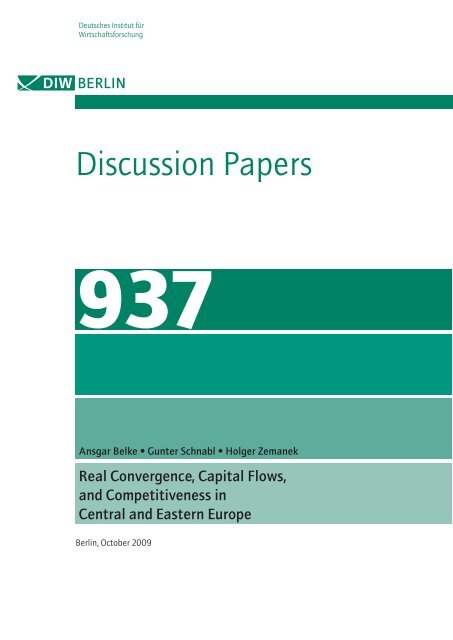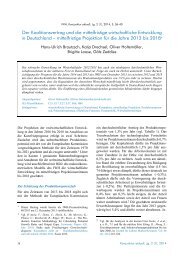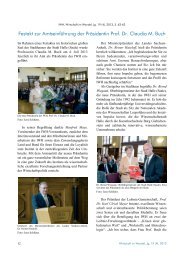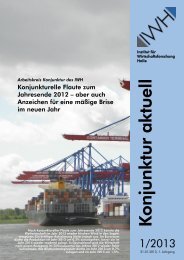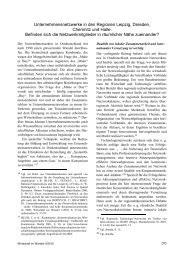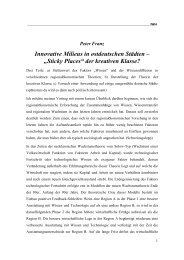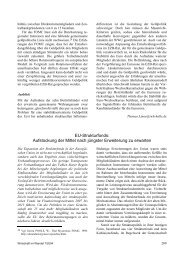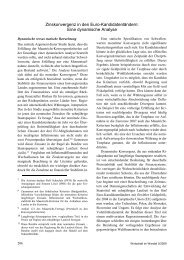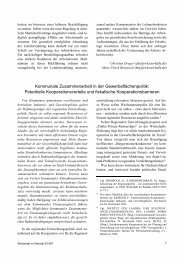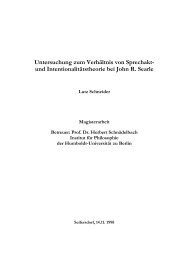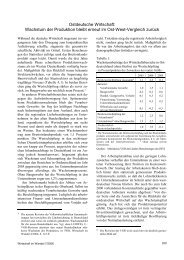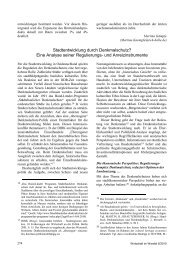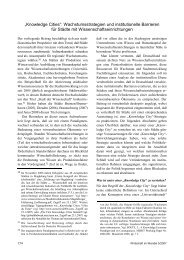Holger Zemanek: Bitte in dem anderne Paper die Anmerkungen von ...
Holger Zemanek: Bitte in dem anderne Paper die Anmerkungen von ...
Holger Zemanek: Bitte in dem anderne Paper die Anmerkungen von ...
Create successful ePaper yourself
Turn your PDF publications into a flip-book with our unique Google optimized e-Paper software.
Deutsches Institut für<br />
Wirtschaftsforschung<br />
Discussion <strong>Paper</strong>s<br />
937<br />
Ansgar Belke Gunter Schnabl <strong>Holger</strong> <strong>Zemanek</strong><br />
Real Convergence, Capital Flows,<br />
and Competitiveness <strong>in</strong><br />
Central and Eastern Europe<br />
Berl<strong>in</strong>, October 2009<br />
www.diw.de
Op<strong>in</strong>ions expressed <strong>in</strong> this paper are those of the author and do not necessarily reflect<br />
views of the <strong>in</strong>stitute.<br />
IMPRESSUM<br />
© DIW Berl<strong>in</strong>, 2009<br />
DIW Berl<strong>in</strong><br />
German Institute for Economic Research<br />
Mohrenstr. 58<br />
10117 Berl<strong>in</strong><br />
Tel. +49 (30) 897 89-0<br />
Fax +49 (30) 897 89-200<br />
http://www.diw.de<br />
ISSN pr<strong>in</strong>t edition 1433-0210<br />
ISSN electronic edition 1619-4535<br />
Available for free download<strong>in</strong>g from the DIW Berl<strong>in</strong> website.<br />
Discussion <strong>Paper</strong>s of DIW Berl<strong>in</strong> are <strong>in</strong>dexed <strong>in</strong> RePEc and SSRN.<br />
<strong>Paper</strong>s can be downloaded free of charge from the follow<strong>in</strong>g websites:<br />
http://www.diw.de/english/products/publications/discussion_papers/27539.html<br />
http://ideas.repec.org/s/diw/diwwpp.html<br />
http://papers.ssrn.com/sol3/JELJOUR_Results.cfm?form_name=journalbrowse&journal_id=1079991
Real Convergence, Capital Flows, and Competitiveness <strong>in</strong> Central<br />
and Eastern Europe*<br />
Ansgar Belke 1<br />
Gunter Schnabl 2<br />
<strong>Holger</strong> <strong>Zemanek</strong> 3<br />
15 October 2009<br />
Abstract<br />
The paper scrut<strong>in</strong>izes the role of wages and capital flows for competitiveness <strong>in</strong> the new EU<br />
member states <strong>in</strong> the context of real convergence. For this purpose it extends the sem<strong>in</strong>al<br />
Balassa-Samuelson model by <strong>in</strong>ternational capital markets. The augmented Balassa-<br />
Samuelson model is l<strong>in</strong>ked to the monetary over<strong>in</strong>vestment theories of Wicksell and Hayek <strong>in</strong><br />
order to trace cyclical deviations of real exchange rates from the productivity-driven<br />
equilibrium path. Panel estimations for the period from 1993 to 2008 reveal mixed evidence<br />
for the role of capital markets for both the economic catch-up process and <strong>in</strong>ternational<br />
competitiveness of the Central and Eastern European countries.<br />
JEL Codes: E24, F16, F31, F32<br />
Keywords: Exchange rate regime, wages, Central and Eastern Europe, EMU accession, panel<br />
model<br />
* We are grateful for valuable comments to Jan Babecky, Mathilde Maurel, Vaclav Zdarek<br />
and other participants <strong>in</strong> the CICM Conference on “20 Years of Transition <strong>in</strong> Central and<br />
Eastern Europe: Money, Bank<strong>in</strong>g and F<strong>in</strong>ancial Markets”, September 17-18, 2009, London.<br />
1<br />
University of Duisburg-Essen, DIW Berl<strong>in</strong> and IZA Bonn, Universitätsstraße 12, 45112 Essen, Germany,<br />
ansgar.belke@uni-due.de<br />
2<br />
University of Leipzig, Grimmaische Straße 12, 04109 Leipzig, Germany, schnabl@wifa.uni-leipzig.de<br />
3<br />
University of Leipzig, Grimmaische Straße 12, 04109 Leipzig, Germany, zemanek@wifa.uni-leipzig.de
1. Introduction<br />
S<strong>in</strong>ce the start of the transformation process, the productivity of the <strong>in</strong>dustrial sector has been<br />
regarded as a crucial determ<strong>in</strong>ant of economic development and wealth <strong>in</strong> Central and Eastern<br />
Europe. Ris<strong>in</strong>g productivity <strong>in</strong> the <strong>in</strong>dustrial sector has been accompanied by ris<strong>in</strong>g GDP per<br />
capita. In the context of the economic catch-up process negative current account balances<br />
have been, on the one hand, <strong>in</strong>terpreted as the outcome of higher returns on <strong>in</strong>vestment. On<br />
the other hand, s<strong>in</strong>ce the turn of the millennium up to the 2008/09 f<strong>in</strong>ancial and economic<br />
crisis, ris<strong>in</strong>g current account deficits of many Central and Eastern European countries have<br />
been taken as an <strong>in</strong>dication of decl<strong>in</strong><strong>in</strong>g competitiveness. When the crisis struck, high current<br />
account deficits were l<strong>in</strong>ked to f<strong>in</strong>ancial vulnerability and crisis.<br />
The issue of productivity catch-up and relative price level development <strong>in</strong> Central and Eastern<br />
Europe has been modelled extensively based on the sem<strong>in</strong>al Balassa-Samuelson framework<br />
(Balassa 1964, Samuelson 1964). Empirical estimations concern<strong>in</strong>g the existence of the<br />
Balassa-Samuelson effect <strong>in</strong> Central and Eastern Europe (see for <strong>in</strong>stance Buiter and Grafe<br />
2002, De Grauwe and Schnabl 2005, Mihaljek and Klau 2008, Égert and Podpiera 2008) have<br />
come to mixed results, lead<strong>in</strong>g to scepticism (see for <strong>in</strong>stance Égert and Podpiera 2008).<br />
We extend the literature on the Balassa-Samuelson effect <strong>in</strong> Central and Eastern Europe <strong>in</strong><br />
two regards. First, we take <strong>in</strong>to account that f<strong>in</strong>ancial markets have ga<strong>in</strong>ed a prom<strong>in</strong>ent role<br />
for the economic development of emerg<strong>in</strong>g market economies compared to the 1960s. We<br />
therefore augment the sem<strong>in</strong>al goods market based Balassa-Samuelson model by capital<br />
markets. The additional availability of foreign capital via portfolio <strong>in</strong>vestment and foreign<br />
direct <strong>in</strong>vestment (FDI) is likely to accelerate the catch-up of productivity and prices.<br />
Second, we acknowledge the fact that <strong>in</strong>ternational capital markets have tended to be highly<br />
cyclical. While Balassa (1964) and Samuelson (1964) <strong>in</strong>terpreted the economic catch-up<br />
process as an equilibrium phenomenon (which does not affect <strong>in</strong>ternational competitiveness<br />
and the current account balance), we take <strong>in</strong>to account the sem<strong>in</strong>al over<strong>in</strong>vestment theories of<br />
Hayek (1929) and Wicksell (1898) to model fluctuations <strong>in</strong> the real exchange rate,<br />
<strong>in</strong>ternational competitiveness and current account balances <strong>in</strong> the Central and Eastern Europe.<br />
As will be shown, our twofold <strong>in</strong>novation helps to trace the most recent boom and bust cycle<br />
<strong>in</strong> Central and Eastern Europe. While open capital markets have accelerated the catch-up<br />
- 2 -
process, the credit boom <strong>in</strong> some Central and Eastern European countries has led to ris<strong>in</strong>g<br />
current account deficits which can be associated with decl<strong>in</strong><strong>in</strong>g competitiveness and<br />
vulnerability to crisis. The results of our panel estimation exercise provide some <strong>in</strong>dication for<br />
an impact of capital <strong>in</strong>flows on the competitiveness of the Central and Eastern European<br />
countries as well as a mitigat<strong>in</strong>g impact of capital flows on the orig<strong>in</strong>al Balassa-Samuelson<br />
effect.<br />
2. The Balassa-Samuelson model augmented with capital markets<br />
Previous research has <strong>in</strong>tensively discussed the impact of the economic catch-up process on<br />
<strong>in</strong>flation and competitiveness <strong>in</strong> emerg<strong>in</strong>g market economies. The sem<strong>in</strong>al Balassa-<br />
Samuelson supply-side hypothesis (Balassa 1964, Samuelson 1964) has been augmented by<br />
<strong>dem</strong>and-side effects (Bergstrand 1991) and other issues <strong>in</strong>clud<strong>in</strong>g quality improvements<br />
(Égert and Podpiera 2008). Less attention has been paid to the role of <strong>in</strong>ternational capital<br />
markets for <strong>in</strong>flation and competitiveness <strong>in</strong> countries which f<strong>in</strong>d themselves <strong>in</strong> an economic<br />
catch-up process.<br />
2.1. The basel<strong>in</strong>e Balassa-Samuelson model<br />
In the 1960s, Balassa (1964) and Samuelson (1964) observed that fast grow<strong>in</strong>g emerg<strong>in</strong>g<br />
markets, much the same as today the Central and Eastern European economies, experienced<br />
higher productivity ga<strong>in</strong>s <strong>in</strong> the tradable sector than <strong>in</strong>dustrial countries. At the same time<br />
higher consumer price <strong>in</strong>flation contributed to a secular “catch-up” of general price levels.<br />
The real convergence process as it is currently observed <strong>in</strong> Central and Eastern Europe was<br />
l<strong>in</strong>ked to nom<strong>in</strong>al convergence <strong>in</strong> terms of consumer price levels and, given fixed exchange<br />
rates, a real appreciation of the domestic currencies. Given that the Balassa-Samuelson effect<br />
had also an impact on prices and the real exchange rate it can be l<strong>in</strong>ked to issues of<br />
<strong>in</strong>ternational competitiveness.<br />
The basic version of the Balassa-Samuelson model is a two-country model with a tradable<br />
goods (<strong>in</strong>dustry) and a non-tradable goods (service) sector as described by De Grauwe and<br />
Schnabl (2005). Balassa (1964) and Samuelson (1964) assumed perfect competition <strong>in</strong> the<br />
tradable goods markets as represented by purchas<strong>in</strong>g power parity and perfect mobility <strong>in</strong><br />
- 3 -
national labour markets, but with no <strong>in</strong>ternational labour mobility. However, competition<br />
between the non-traded goods sectors of the two countries and between the traded and non-<br />
traded goods sector <strong>in</strong> domestic markets was supposed to be absent.<br />
In the follow<strong>in</strong>g, we assume that the production of traded and non-traded goods <strong>in</strong> each<br />
country is based on two Cobb-Douglas production functions for the traded goods sector T and<br />
the non-traded goods sector NT:<br />
Y<br />
i<br />
= A<br />
i<br />
i<br />
i i γ i 1−γ<br />
( K ) ( L ) with 0 < γ i < 1 and i = T, NT (1)<br />
In equation (1) Y i is the (real) output; A i represents technology; K i stands for (fixed) capital;<br />
and L i is the labour force employed <strong>in</strong> sector i. 1 In both sectors, output is generated by<br />
comb<strong>in</strong><strong>in</strong>g technology, capital and labour. Assum<strong>in</strong>g competitive markets and profit<br />
i<br />
i Y<br />
maximization, the marg<strong>in</strong>al productivity of labour ( ( 1−<br />
γ ) ) must correspond to the real<br />
i<br />
L<br />
wage <strong>in</strong> the respective sector which is def<strong>in</strong>ed as the nom<strong>in</strong>al wage divided by the price level<br />
of the respective goods:<br />
i i<br />
i Y W<br />
( 1−<br />
γ ) =<br />
(2)<br />
i i<br />
L P<br />
Nom<strong>in</strong>al wages <strong>in</strong> the traded and non-traded sectors are supposed to be equal as perfect<br />
T NT<br />
labour mobility between the traded and non-traded sector is assumed ( W = W = W ). This<br />
yields:<br />
T NT<br />
Q P<br />
c = (3)<br />
NT T<br />
Q P<br />
where Q i i<br />
Y 2<br />
represent the labour productivities <strong>in</strong> the respective sectors ( ) and c is a positive i<br />
T<br />
1−<br />
γ<br />
constant depend<strong>in</strong>g on the weights of tradable and non-tradable goods ( ). Tak<strong>in</strong>g the<br />
NT<br />
1−<br />
γ<br />
1 The overall labor force of the economy L is assumed to be constant:<br />
2 As γ T and γ NT are larger than zero and smaller than unity.<br />
- 4 -<br />
L +<br />
L<br />
T NT<br />
= L L .
first derivation, changes 3 <strong>in</strong> the productivity differential between the traded and non-traded<br />
i<br />
goods sector are determ<strong>in</strong>ed by relative price changes ( pˆ ) between non-traded and traded<br />
goods. Balassa (1964) and Samuelson (1964) also assumed that productivity growth is larger<br />
<strong>in</strong> the traded goods than <strong>in</strong> the non-traded goods sector.<br />
NT<br />
T<br />
[ qˆ<br />
T qNT<br />
pˆ − pˆ<br />
= c − ˆ ]<br />
with qˆ<br />
qˆ<br />
> 0<br />
(4)<br />
]<br />
T<br />
− NT<br />
As long as productivity <strong>in</strong> the traded goods sector is grow<strong>in</strong>g faster than <strong>in</strong> the non-traded<br />
goods sector, prices <strong>in</strong> the non-traded goods sector rise relative to prices <strong>in</strong> the traded goods<br />
sector. Overall <strong>in</strong>flation can be assumed to be a composite of traded and non-traded goods<br />
with the weights α and (1-α):<br />
pˆ = αpˆ + ( 1−<br />
α)<br />
pˆ<br />
(5)<br />
T<br />
NT<br />
Given equations (4) and (5), the domestic price level is a function of the domestically-traded<br />
goods price level and the productivity growth differential between the traded and non-traded<br />
goods sector. With constant traded goods prices<br />
( pˆ<br />
T<br />
= 0)<br />
productivity <strong>in</strong>creases of traded goods versus non-traded goods.<br />
T<br />
[ qˆ<br />
T qNT<br />
<strong>in</strong>flation is driven by relative<br />
pˆ = pˆ<br />
+ ( 1−<br />
α ) c − ˆ<br />
(6)<br />
The impact of <strong>in</strong>ternational goods markets can be modelled based on the assumption by<br />
Balassa (1964) and Samuelson (1964) that <strong>in</strong> goods markets purchas<strong>in</strong>g power parity holds,<br />
i.e. domestic traded goods <strong>in</strong>flation<br />
pˆ T<br />
is equivalent to traded goods <strong>in</strong>flation on world or euro<br />
EA<br />
area traded goods markets pˆ , corrected by exchange rate changes e ˆ :<br />
T<br />
EA<br />
pˆ<br />
= pˆ<br />
+ eˆ<br />
(7)<br />
T<br />
T<br />
Insert<strong>in</strong>g equation (7) <strong>in</strong>to equation (6) yields equation (8) which can be seen as an equation<br />
to determ<strong>in</strong>e supply driven <strong>in</strong>flation, tak<strong>in</strong>g <strong>in</strong>to account <strong>in</strong>ternational goods markets and the<br />
exchange rate. The term ( 1−<br />
α)<br />
c is a positive constant depend<strong>in</strong>g on the weights of traded<br />
3 Exchange rates are expressed <strong>in</strong> small letters with with a ^.<br />
- 5 -
and non-traded goods <strong>in</strong> the economy and the consumer price <strong>in</strong>dex.<br />
EA<br />
T<br />
[ qˆ<br />
T qNT<br />
pˆ = pˆ<br />
+ eˆ<br />
+ ( 1−α<br />
) c − ˆ ]<br />
Accord<strong>in</strong>g to equation (8), <strong>in</strong>flation <strong>in</strong> Central and Eastern European countries is driven by<br />
<strong>in</strong>flation <strong>in</strong> the euro area traded goods sector (as the ma<strong>in</strong> reference market for Central and<br />
Eastern Europe), exchange rate changes aga<strong>in</strong>st the euro and the differential of productivity<br />
ga<strong>in</strong>s between the traded and non-traded goods sectors.<br />
Based on equation (8) two corner solutions of exchange rate regimes can be dist<strong>in</strong>guished.<br />
Under a fixed exchange rate regime (ê=0) the exchange rate term drops out and domestic<br />
<strong>in</strong>flation would be solely driven by domestic productivity development and price<br />
development <strong>in</strong> world markets. Under flexible exchange rates, exchange rate changes would<br />
constitute a pivotal additional determ<strong>in</strong>ant of domestic <strong>in</strong>flation.<br />
2.2 Capital markets and a new equilibrium path<br />
The Balassa-Samuelson model is a pure goods market model. Productivity <strong>in</strong>creases are<br />
assumed to be exogenous and driven by domestic capital formation. This assumption was<br />
realistic dur<strong>in</strong>g the Bretton-Woods system when <strong>in</strong>ternational private capital flows were<br />
strongly restricted. Current account deficits were ma<strong>in</strong>ly subject to government f<strong>in</strong>anc<strong>in</strong>g, and<br />
therefore usually not susta<strong>in</strong>able and small. In contrast to the emerg<strong>in</strong>g markets <strong>in</strong> the 1950s,<br />
<strong>in</strong>vestment and productivity <strong>in</strong> Central and Eastern Europe up to the 2008/09 crisis has been<br />
driven by substantial capital <strong>in</strong>flows from the highly developed, low <strong>in</strong>terest rate euro and<br />
dollar capital markets via foreign direct <strong>in</strong>vestment and bank lend<strong>in</strong>g. 4 This has been reflected<br />
<strong>in</strong> ris<strong>in</strong>g current account deficits.<br />
Introduc<strong>in</strong>g capital markets <strong>in</strong>to the Balassa-Samuelson model modifies the adjustment<br />
mechanism <strong>in</strong> two ways. First, because capital markets <strong>in</strong> emerg<strong>in</strong>g market economies are<br />
shallow, underdeveloped and rather closed (Eichengreen and Hausmann 1999), capital tends<br />
to be scarce which constitutes a bottleneck for domestic productivity <strong>in</strong>creases, growth, and<br />
economic development. Open<strong>in</strong>g up to <strong>in</strong>ternational capital markets is equivalent to provid<strong>in</strong>g<br />
4<br />
In contrast to Emerg<strong>in</strong>g Europe, <strong>in</strong> East Asia and other parts of the emerg<strong>in</strong>g world current account surpluses<br />
have emerged (Freitag and Schnabl 2008).<br />
- 6 -<br />
(8)
a higher supply of capital at a substantially lower <strong>in</strong>terest rate. Portfolio <strong>in</strong>vestment and<br />
<strong>in</strong>flows of bank credit allow upgrad<strong>in</strong>g the domestic production technologies and <strong>in</strong>vestment<br />
<strong>in</strong> new production sites. The <strong>in</strong>flow of FDI is equivalent to substitut<strong>in</strong>g relatively <strong>in</strong>efficient<br />
production sites by lead<strong>in</strong>g edge production technologies. In both cases labour productivity<br />
and overall productivity <strong>in</strong>creases.<br />
Second, <strong>in</strong> the context of the Balassa-Samuelson framework the direction of wage and<br />
productivity adjustment may change. For <strong>in</strong>stance, Goretti (2008) observes for Central and<br />
Eastern Europe that wage <strong>in</strong>creases orig<strong>in</strong>ated <strong>in</strong> the non-traded goods sector and were<br />
followed by wage <strong>in</strong>creases <strong>in</strong> the traded goods sector. In the Central and Eastern European<br />
countries capital <strong>in</strong>flows may reflect privatizations receipts as public enterprises are sold off<br />
to <strong>in</strong>ternational <strong>in</strong>vestors. The privatization receipts would allow for public sector wage<br />
<strong>in</strong>creases which would trigger wage adjustment <strong>in</strong> the other parts of the non-traded goods<br />
sector and <strong>in</strong> the traded goods sector. The wage <strong>in</strong>crease <strong>in</strong> the traded goods sector would<br />
then – given constant world market prices – necessitate productivity <strong>in</strong>creases <strong>in</strong> the traded<br />
goods sector to ma<strong>in</strong>ta<strong>in</strong> <strong>in</strong>ternational competitiveness. The direction of the adjustment<br />
process of wages and productivity is reversed.<br />
As experienced by Central and Eastern European countries, <strong>in</strong>ternational capital <strong>in</strong>flows have<br />
been target<strong>in</strong>g <strong>in</strong> the first place the <strong>in</strong>dustrial (tradable goods) sector as well as the nontradable<br />
sector such as the bank<strong>in</strong>g sector. Generally the capital <strong>in</strong>flows <strong>in</strong>to the region have<br />
contributed to productivity <strong>in</strong>creases <strong>in</strong> both sectors by provid<strong>in</strong>g more efficient production<br />
technologies and management knowhow than <strong>in</strong> a sett<strong>in</strong>g without <strong>in</strong>ternational capital<br />
markets. The assumption of Balassa (1964) and Samuelson (1964) that the potential for<br />
productivity <strong>in</strong>creases <strong>in</strong> the traded goods (<strong>in</strong>dustrial) sector is higher than <strong>in</strong> the non-traded<br />
goods (services) sector can be ma<strong>in</strong>ta<strong>in</strong>ed, as the potential for productivity <strong>in</strong>creases <strong>in</strong> the<br />
non-traded and traded goods sector rema<strong>in</strong>s unchanged under both environments<br />
( qˆ > qˆ<br />
).<br />
Tcap<br />
NTcap<br />
5<br />
This is confirmed by Figure 1 which shows the average productivity <strong>in</strong>creases <strong>in</strong> the traded<br />
and non-traded sectors of eleven Central and Eastern European countries. To decompose<br />
overall productivity <strong>in</strong>creases <strong>in</strong>to productivity <strong>in</strong>creases orig<strong>in</strong>at<strong>in</strong>g from domestic capital<br />
formation and those which stem from capital <strong>in</strong>flows we split sectoral output <strong>in</strong> domestic<br />
5 The subscript „cap“ denotes that the Balassa-Samuelson model is extended to capital markets.<br />
- 7 -
driven output and foreign capital <strong>in</strong>flow related output. Relative labour productivity <strong>in</strong>creases<br />
qˆ − qˆ<br />
T<br />
NT<br />
are decomposed <strong>in</strong>to labour productivity <strong>in</strong>creases driven by domestic capital<br />
formation and labour productivity <strong>in</strong>creases driven by capital <strong>in</strong>flows (see Annex for<br />
derivation):<br />
cap<br />
EA<br />
T<br />
T<br />
NT<br />
[ qˆ<br />
− qˆ<br />
] + d[<br />
qˆ<br />
q ]<br />
qˆ − qˆ<br />
= c<br />
− ˆ . This yields:<br />
dom<br />
Tdom<br />
NTdom<br />
Tcap<br />
NTcap<br />
[ qˆ<br />
− qˆ<br />
] + b [ qˆ<br />
q ]<br />
pˆ = pˆ<br />
+ eˆ<br />
+ b<br />
− ˆ<br />
Tdom<br />
NTdom<br />
cap<br />
Tcap<br />
NTcap<br />
with qˆ > qˆ<br />
, qˆ Tcap > qˆ<br />
NTcap<br />
Given capital <strong>in</strong>flows, domestic <strong>in</strong>flation should be higher than <strong>in</strong> an economy with a closed<br />
capital account ( pcap p ). The coefficient bdom is equal to (1-α)c and bcap is equal to (1-α)d<br />
(see Annex for derivation) with both be<strong>in</strong>g positive constants. Add<strong>in</strong>g capital <strong>in</strong>flows to the<br />
model implies <strong>in</strong> the first place a disequilibrium between current account and f<strong>in</strong>ancial<br />
account, because the net capital <strong>in</strong>flows would not fully be used for purchases of foreign<br />
goods. Yet, the relative price <strong>in</strong>crease of non-traded goods shifts <strong>dem</strong>and from non-traded to<br />
traded goods and the current account and the f<strong>in</strong>ancial account will be balanced.<br />
percent<br />
10<br />
8<br />
6<br />
4<br />
2<br />
0<br />
-2<br />
ˆ ><br />
ˆ<br />
Tdom<br />
NTdom<br />
Figure 1 - Productivity growth <strong>in</strong> the tradable and non-tradable sector<br />
tradable sector<br />
non-tradable sector<br />
1994 1995 1996 1997 1998 1999 2000 2001 2002 2003 2004 2005 2006 2007 2008<br />
Source: European Commission. Arithmetic averages of even Central and Eastern European countries.<br />
Productivity is measured by changes of real value added per person employed.<br />
- 8 -<br />
(9)
Assum<strong>in</strong>g for simplicity that the price levels of traded as well as non-traded goods <strong>in</strong> the euro<br />
EA EA EA<br />
area are constant, i.e. pˆ<br />
= pˆ<br />
= pˆ<br />
= 0 , the real exchange rate of the emerg<strong>in</strong>g market<br />
economy eˆ − pˆ<br />
will be a negative function of the productivity differential between the<br />
cap<br />
traded and the non-traded goods sectors.<br />
−<br />
T<br />
( eˆ − pˆ<br />
) = b [ qˆ<br />
− qˆ<br />
] + b [ qˆ<br />
− qˆ<br />
]<br />
cap<br />
dom<br />
Tdom<br />
NTdom<br />
NT<br />
cap<br />
Tcap<br />
The real appreciation of the emerg<strong>in</strong>g market currency dur<strong>in</strong>g the economic catch-up process<br />
as reflected by the negative sign of the left hand side of equation (8) is driven by the catch-up<br />
of productivity. As shown by De Grauwe and Schnabl (2005) this real appreciation can be<br />
achieved either by a nom<strong>in</strong>al appreciation of the exchange rate (-ê) or relative price <strong>in</strong>creases<br />
versus the euro area ( + pˆ ) as assumed by Balassa (1964) and Samuelson (1964). In both<br />
cap<br />
cases the current account balance would be unchanged. In both cases the real appreciation<br />
would be a steady process which reflects relative productivity catch-up, but not changes <strong>in</strong><br />
<strong>in</strong>ternational competitiveness and the current account position. Thus, add<strong>in</strong>g <strong>in</strong>ternational<br />
capital markets implies an accelerated real appreciation path (Figure 2).<br />
NTcap<br />
Figure 2 - Goods and capital market driven real appreciation path<br />
- 9 -<br />
(10)
3. Changes <strong>in</strong> <strong>in</strong>ternational competitiveness and cyclical fluctuations due to<br />
capital flows<br />
Balassa (1964) and Samuelson (1964) assumed that productivity growth <strong>in</strong> the economic<br />
catch-up is a gradual process without changes <strong>in</strong> the current account position. Productivity<br />
<strong>in</strong>creases <strong>in</strong> the <strong>in</strong>dustrial sector are balanced by relative price changes leav<strong>in</strong>g<br />
competitiveness unchanged. Nevertheless it has been observed that the current account<br />
positions of emerg<strong>in</strong>g market economies have deteriorated or fluctuated dur<strong>in</strong>g the economic<br />
catch-up process. As recently <strong>in</strong> Central and Eastern Europe, high current account deficits<br />
have been perceived as an <strong>in</strong>dication for eroded competitiveness, economic turmoil, and crisis.<br />
In the follow<strong>in</strong>g, changes <strong>in</strong> <strong>in</strong>ternational competitiveness are def<strong>in</strong>ed as wage <strong>in</strong>creases<br />
higher than productivity <strong>in</strong>creases and are l<strong>in</strong>ked to ris<strong>in</strong>g current account deficits and cyclical<br />
fluctuations <strong>in</strong> <strong>in</strong>ternational capital <strong>in</strong>flows.<br />
3.1. Changes <strong>in</strong> <strong>in</strong>ternational competitiveness<br />
L<strong>in</strong>dbeck (1979) l<strong>in</strong>ked the domestically driven wage barga<strong>in</strong><strong>in</strong>g process of Balassa (1964)<br />
and Samuelson (1964) to <strong>in</strong>ternational goods markets. He assumed <strong>in</strong> l<strong>in</strong>e with equation (1)<br />
that trade unions <strong>in</strong> the traded goods sector of countries <strong>in</strong> the economic catch-up process do<br />
not negotiate wage <strong>in</strong>creases higher than productivity <strong>in</strong>creases and world market <strong>in</strong>flation.<br />
By do<strong>in</strong>g this they help to ma<strong>in</strong>ta<strong>in</strong> the competitiveness of the domestic export <strong>in</strong>dustry (and<br />
therefore prevent ris<strong>in</strong>g unemployment). In contrast, <strong>in</strong> emerg<strong>in</strong>g markets with buoyant<br />
capital <strong>in</strong>flows wages may rise above domestic productivity <strong>in</strong>creases.<br />
Y<br />
W<br />
i i<br />
i cap<br />
( 1−<br />
γ ) i<br />
Lcap<br />
<<br />
cap<br />
i<br />
Pcap<br />
(11)<br />
If nom<strong>in</strong>al wages <strong>in</strong> the traded and non-traded sectors are assumed to be equal due to perfect<br />
labor mobility between sectors this yields:<br />
Q P<br />
c < (12)<br />
Q P<br />
T<br />
cap<br />
NT<br />
cap<br />
NT<br />
cap<br />
T<br />
cap<br />
In equation (12) as outl<strong>in</strong>ed above the direction of causality may have changed compared to<br />
- 10 -
the sem<strong>in</strong>al Balassa-Samuelson model as capital <strong>in</strong>flows allow for a simultaneous <strong>in</strong>crease of<br />
productivity and wages <strong>in</strong> both sectors with wages <strong>in</strong>creas<strong>in</strong>g faster than productivity. The<br />
outcome is that domestic <strong>in</strong>flation <strong>in</strong> the country <strong>in</strong> the economic catch-up process rises above<br />
what would otherwise be justified by relative productivity <strong>in</strong>creases. Domestic <strong>in</strong>flation is<br />
decomposed <strong>in</strong> a factor driven by relative productivity <strong>in</strong>creases orig<strong>in</strong>at<strong>in</strong>g <strong>in</strong> domestic<br />
capital formation and one which is driven by capital <strong>in</strong>flows.<br />
cap<br />
EA<br />
T<br />
dom<br />
[ qˆ<br />
− qˆ<br />
] + b [ qˆ<br />
q ]<br />
pˆ > pˆ<br />
+ eˆ<br />
+ b<br />
− ˆ<br />
Tdom<br />
NTdom<br />
cap<br />
Tcap<br />
NTcap<br />
qˆ with Tdom > qˆ<br />
qˆ NTdom Tcap > qˆ<br />
NTcap<br />
, (13)<br />
The outcome would be that – assum<strong>in</strong>g constant prices for traded and non-traded goods <strong>in</strong> the<br />
euro area – the real appreciation of the emerg<strong>in</strong>g market currency would go beyond what<br />
would be <strong>in</strong>dicated by the emerg<strong>in</strong>g markets relative productivity ga<strong>in</strong>s.<br />
−<br />
( eˆ − pˆ<br />
) > b [ qˆ<br />
− qˆ<br />
] + b [ qˆ<br />
− qˆ<br />
]<br />
cap<br />
dom<br />
Tdom<br />
NTdom<br />
cap<br />
Tcap<br />
NTcap<br />
with , (14)<br />
NTdom<br />
Tdom qˆ > qˆ<br />
qˆ Tcap > qˆ<br />
NTcap<br />
The gradual deviation of the real exchange rate from the productivity-driven path is modelled<br />
<strong>in</strong> Figure 3. The consequence of a real appreciation beyond what would be justified by<br />
relative productivity <strong>in</strong>creases is a deteriorated current account position which is fuelled by<br />
capital <strong>in</strong>flows.<br />
Figure 3 - Goods and capital market driven real appreciation path II<br />
Real exchange rate<br />
t0<br />
Balassa-Samuelson goods market approach<br />
Equilibrium path with capital <strong>in</strong>flows<br />
Appreciation path beyond productivity <strong>in</strong>creases<br />
- 11 -<br />
t
3.2. Cyclical fluctuations <strong>in</strong> competitiveness<br />
A deviation of the productivity driven real appreciation path as modelled <strong>in</strong> Figure 3 can not<br />
go for ever as the underly<strong>in</strong>g <strong>in</strong>vestment would turn out to have a low or negative profitability.<br />
Capital <strong>in</strong>flows that nurture wage <strong>in</strong>creases <strong>in</strong>stead of productivity <strong>in</strong>creases would be<br />
reversed and competitiveness would have to be restored via nom<strong>in</strong>al exchange rate<br />
depreciation or real wage cuts. This suggests cyclical deviations from the real appreciation<br />
path.<br />
Such cyclical deviations from this productivity-driven real appreciation path may occur if –<br />
given sound macroeconomic fundamentals and/or low <strong>in</strong>terest rate levels <strong>in</strong> the <strong>in</strong>ternational<br />
capital markets – buoyant <strong>in</strong>ternational capital <strong>in</strong>flows contribute to brisk monetary expansion,<br />
fast ris<strong>in</strong>g credit growth and over<strong>in</strong>vestment. In particular, as <strong>in</strong>ternational capital markets <strong>in</strong><br />
emerg<strong>in</strong>g market economies are underdeveloped, buoyant and excessive capital <strong>in</strong>flows can<br />
be easily reversed when economic sentiment changes. Then, euphoric <strong>in</strong>vestment booms,<br />
wage hikes, and fast real appreciation are followed by severe recessions, real wage cuts, and<br />
real depreciation. Inflation <strong>in</strong> Central and Eastern Europe has not only tended to be higher<br />
than <strong>in</strong> the euro area (as assumed by the Balassa-Samuelson hypothesis), it has also exhibited<br />
strong cyclical fluctuations as shown <strong>in</strong> Figure 4 (what is not modelled by the Balassa-<br />
Samuelson effect). The strong cyclicality of <strong>in</strong>flation <strong>in</strong> Central and Eastern Europe may po<strong>in</strong>t<br />
at a prom<strong>in</strong>ent role of capital <strong>in</strong>flows for <strong>in</strong>flation <strong>in</strong> these catch<strong>in</strong>g-up economies.<br />
The sem<strong>in</strong>al monetary over<strong>in</strong>vestment theories by Hayek (1929) and Wicksell (1898) and<br />
more recent research (McK<strong>in</strong>non and Pill 1997, Krugman 1998, Corsetti et al. 1999, Saxena<br />
and Wong 2002, Hoffmann and Schnabl 2008) provide theoretical frameworks suitable to<br />
expla<strong>in</strong> capital market-driven fluctuations <strong>in</strong> <strong>in</strong>flation, wages and a (temporary) departure of<br />
the real exchange rate from the equilibrium path. To model bus<strong>in</strong>ess cycle fluctuations <strong>in</strong><br />
closed economies, Wicksell (1898) and Hayek (1929) dist<strong>in</strong>guished between “good”<br />
<strong>in</strong>vestment which yields returns above a “natural” equilibrium <strong>in</strong>terest rate 6 and low return<br />
(speculative) <strong>in</strong>vestment which is <strong>in</strong>duced by an <strong>in</strong>terest rate below the equilibrium (I>S).<br />
Over<strong>in</strong>vestment is triggered when the central bank (Wicksell 1898) or the bank<strong>in</strong>g sector<br />
(Hayek 1929) keep <strong>in</strong>terest rates below the equilibrium <strong>in</strong>terest rate dur<strong>in</strong>g the economic<br />
upsw<strong>in</strong>g. Whereas the monetary over<strong>in</strong>vestment theories were modelled for closed economies,<br />
6 At the equilibrium <strong>in</strong>terest rate, sav<strong>in</strong>g is equal to <strong>in</strong>vestment: S=I.<br />
- 12 -
<strong>in</strong> today’s liberalized <strong>in</strong>ternational capital markets <strong>in</strong>terest rates <strong>in</strong> emerg<strong>in</strong>g markets can<br />
decl<strong>in</strong>e “below the natural <strong>in</strong>terest rate” due to buoyant capital <strong>in</strong>flows from highly liquid,<br />
low yield developed capital markets (Hoffmann and Schnabl 2008).<br />
Over<strong>in</strong>vestment is <strong>in</strong>duced dur<strong>in</strong>g the economic upsw<strong>in</strong>g (boom), for <strong>in</strong>stance, because<br />
(<strong>in</strong>ternational) f<strong>in</strong>ancial <strong>in</strong>stitutions (for <strong>in</strong>stance <strong>in</strong> the euro area) compete for borrow<strong>in</strong>g to<br />
high-yield emerg<strong>in</strong>g market economies (for <strong>in</strong>stance <strong>in</strong> Central and Eastern Europe). Together<br />
with decl<strong>in</strong><strong>in</strong>g ref<strong>in</strong>anc<strong>in</strong>g costs for banks and lower lend<strong>in</strong>g rates for enterprises, the<br />
(expected) profitability of the realized <strong>in</strong>vestment projects decreases (for <strong>in</strong>stance represented<br />
by decl<strong>in</strong><strong>in</strong>g productivity <strong>in</strong>creases <strong>in</strong> Central and Eastern Europe as shown <strong>in</strong> Figure 1).<br />
Moral hazard <strong>in</strong> f<strong>in</strong>anc<strong>in</strong>g low return <strong>in</strong>vestment may occur when f<strong>in</strong>ancial <strong>in</strong>stitutions<br />
anticipate a lender of last resort <strong>in</strong> the case of crisis (Krugman 1998, Corsetti et al. 1999). 7 In<br />
this case, domestic f<strong>in</strong>ancial <strong>in</strong>stitutions tend to borrow to enterprises without an adequate<br />
assessment of the expected returns (McK<strong>in</strong>non and Pill 1997).<br />
In the models of Wicksell (1898) and Hayek (1929) the upsw<strong>in</strong>g cont<strong>in</strong>ues as the <strong>dem</strong>and for<br />
<strong>in</strong>vestment goods rises. In this phase, capacity reserves are activated. What is more, wages<br />
and consumption <strong>in</strong>crease. The positive economic expectations can well be transmitted to<br />
asset markets where speculation may set <strong>in</strong> (Schumpeter 1912). 8 With credit growth<br />
becom<strong>in</strong>g speculative (as it seems to have happened <strong>in</strong> Central and Eastern Europe),<br />
productivity <strong>in</strong>creases slow down (as shown <strong>in</strong> Figure 1). F<strong>in</strong>ally, consumer price <strong>in</strong>flation<br />
accelerates which conveys a signal supportive of build<strong>in</strong>g up additional capacities and<br />
<strong>in</strong>creas<strong>in</strong>g wages further.<br />
7<br />
The IMF and the European Institutions became lenders of last resort <strong>in</strong> Central and Eastern Europe dur<strong>in</strong>g the<br />
current crisis.<br />
8<br />
A speculative mania may emerge, <strong>in</strong> which speculative price projections and “the symptoms of prosperity<br />
themselves f<strong>in</strong>ally become, <strong>in</strong> the well known manner, a factor of prosperity” (Schumpeter 1912, 226).<br />
- 13 -
P e r cen t<br />
P e r cen t<br />
P e r cen t<br />
P e r cen t<br />
25<br />
20<br />
15<br />
10<br />
5<br />
Figure 4 - Inflation <strong>in</strong> Central and Eastern Europe and Germany<br />
0<br />
Jan 93 Jan 96 Jan 99 Jan 02 Jan 05 Jan 08<br />
25<br />
20<br />
15<br />
10<br />
5<br />
Bulgaria<br />
0<br />
Jan 93 Jan 96 Jan 99 Jan 02 Jan 05 Jan 08<br />
25<br />
20<br />
15<br />
10<br />
5<br />
Hungary<br />
0<br />
Jan 93 Jan 96 Jan 99 Jan 02 Jan 05 Jan 08<br />
25<br />
20<br />
15<br />
10<br />
5<br />
Poland<br />
0<br />
Jan 93 Jan 96 Jan 99 Jan 02 Jan 05 Jan 08<br />
Source: IMF.<br />
Slovenia<br />
P e r cen t<br />
P e r cen t<br />
P e r cen t<br />
P e r cen t<br />
25<br />
20<br />
15<br />
10<br />
5<br />
0<br />
Jan 93 Jan 96 Jan 99 Jan 02 Jan 05 Jan 08<br />
25<br />
20<br />
15<br />
10<br />
5<br />
Czech Republic<br />
0<br />
Jan 93 Jan 96 Jan 99 Jan 02 Jan 05 Jan 08<br />
25<br />
20<br />
15<br />
10<br />
5<br />
Latvia<br />
0<br />
Jan 93 Jan 96 Jan 99 Jan 02 Jan 05 Jan 08<br />
25<br />
20<br />
15<br />
10<br />
5<br />
Romania<br />
0<br />
Jan 93 Jan 96 Jan 99 Jan 02 Jan 05 Jan 08<br />
Croatia<br />
- 14 -<br />
P e r cen t<br />
P e r cen t<br />
P e r cen t<br />
P e r cen t<br />
25<br />
20<br />
15<br />
10<br />
5<br />
0<br />
Jan 93 Jan 96 Jan 99 Jan 02 Jan 05 Jan 08<br />
25<br />
20<br />
15<br />
10<br />
5<br />
Estonia<br />
0<br />
Jan 93 Jan 96 Jan 99 Jan 02 Jan 05 Jan 08<br />
25<br />
20<br />
15<br />
10<br />
5<br />
Lithuania<br />
0<br />
Jan 93 Jan 96 Jan 99 Jan 02 Jan 05 Jan 08<br />
25<br />
20<br />
15<br />
10<br />
5<br />
Slovak Republic<br />
0<br />
Jan 93 Jan 96 Jan 99 Jan 02 Jan 05 Jan 08<br />
Germany
Such boom-and-bust cycles <strong>in</strong> emerg<strong>in</strong>g markets have been observed frequently s<strong>in</strong>ce the<br />
mid-1990s (McK<strong>in</strong>non and Pill 1997). In practice, although over<strong>in</strong>vestment may be difficult<br />
to identify ex ante, it can be l<strong>in</strong>ked to buoyant capital <strong>in</strong>flows <strong>in</strong>to the emerg<strong>in</strong>g market<br />
economies which contribute to monetary expansion, decl<strong>in</strong><strong>in</strong>g <strong>in</strong>terest rates and <strong>in</strong>flation<br />
ris<strong>in</strong>g above levels which are justified by productivity growth. Indeed, ris<strong>in</strong>g <strong>in</strong>flation has<br />
been observed <strong>in</strong> many Central and Eastern European countries before the recent crisis<br />
(Figure 4).<br />
Speculative capital <strong>in</strong>flows, overheat<strong>in</strong>g and <strong>in</strong>flation can be seen as the ma<strong>in</strong> reason of strong<br />
real appreciations and ris<strong>in</strong>g current account deficits of the Central and Eastern European<br />
currencies s<strong>in</strong>ce the turn of the millennium (B<strong>in</strong>i-Smaghi 2007). When the crisis hit, the<br />
reversal of the capital flows triggered the dismantl<strong>in</strong>g of <strong>in</strong>vestment projects (i.e. by decl<strong>in</strong><strong>in</strong>g<br />
productivity) as well as nom<strong>in</strong>al exchange rate depreciations and/or wage austerity. A real<br />
depreciation of the emerg<strong>in</strong>g market currency occurred via nom<strong>in</strong>al depreciation for <strong>in</strong>stance<br />
<strong>in</strong> Hungary, Poland, and Romania (Figure 5). In other Central and Eastern European<br />
economies such as the Baltics real depreciation is eng<strong>in</strong>eered via nom<strong>in</strong>al and real wage cuts.<br />
All <strong>in</strong> all, the over<strong>in</strong>vestment and related theories help us to model cyclical fluctuations <strong>in</strong> the<br />
real exchange rate and therefore of fluctuations <strong>in</strong> the competitiveness of the Central and<br />
Eastern European economies dur<strong>in</strong>g the economic catch-up process. As <strong>in</strong>ternational capital<br />
outflows from emerg<strong>in</strong>g markets tend to overshoot <strong>in</strong> times of crisis (because <strong>in</strong>vestors<br />
overestimate the risk), the emerg<strong>in</strong>g market currencies tend to depreciate beyond what would<br />
be compatible with the levels of relative productivity changes. The result<strong>in</strong>g cyclical<br />
evolvement of the real exchange rate is modelled <strong>in</strong> Figure 6.<br />
- 15 -
135<br />
120<br />
105<br />
90<br />
75<br />
60<br />
45<br />
Figure 5 - Real exchange rates, national currency per euro, Index: Jan 1994=100.<br />
30<br />
Jan 94 Aug 95 Mar 97 Oct 98 May 00 Dec 01 Jul 03 Feb 05 Sep 06 Apr 08<br />
135<br />
120<br />
105<br />
90<br />
75<br />
60<br />
45<br />
Bulgaria<br />
30<br />
Jan 94 Aug 95 Mar 97 Oct 98 May 00 Dec 01 Jul 03 Feb 05 Sep 06 Apr 08<br />
135<br />
120<br />
105<br />
90<br />
75<br />
60<br />
45<br />
Hungary<br />
30<br />
Jan 94 Aug 95 Mar 97 Oct 98 May 00 Dec 01 Jul 03 Feb 05 Sep 06 Apr 08<br />
135<br />
120<br />
105<br />
90<br />
75<br />
60<br />
45<br />
Poland<br />
30<br />
Jan 94 Aug 95 Mar 97 Oct 98 May 00 Dec 01 Jul 03 Feb 05 Sep 06 Apr 08<br />
Source: IMF.<br />
Slovenia<br />
135<br />
120<br />
105<br />
90<br />
75<br />
60<br />
45<br />
30<br />
Jan 94 Aug 95 Mar 97 Oct 98 May 00 Dec 01 Jul 03 Feb 05 Sep 06 Apr 08<br />
135<br />
120<br />
105<br />
90<br />
75<br />
60<br />
45<br />
Czech Republic<br />
30<br />
Jan 94 Aug 95 Mar 97 Oct 98 May 00 Dec 01 Jul 03 Feb 05 Sep 06 Apr 08<br />
135<br />
120<br />
105<br />
90<br />
75<br />
60<br />
45<br />
Latvia<br />
30<br />
Jan 94 Aug 95 Mar 97 Oct 98 May 00 Dec 01 Jul 03 Feb 05 Sep 06 Apr 08<br />
135<br />
120<br />
105<br />
90<br />
75<br />
60<br />
45<br />
Romania<br />
30<br />
Jan 94 Aug 95 Mar 97 Oct 98 May 00 Dec 01 Jul 03 Feb 05 Sep 06 Apr 08<br />
Croatia<br />
- 16 -<br />
135<br />
120<br />
105<br />
90<br />
75<br />
60<br />
45<br />
30<br />
Jan 94 Aug 95 Mar 97 Oct 98 May 00 Dec 01 Jul 03 Feb 05 Sep 06 Apr 08<br />
135<br />
120<br />
105<br />
90<br />
75<br />
60<br />
45<br />
Estonia<br />
30<br />
Jan 94 Aug 95 Mar 97 Oct 98 May 00 Dec 01 Jul 03 Feb 05 Sep 06 Apr 08<br />
135<br />
120<br />
105<br />
90<br />
75<br />
60<br />
45<br />
Lithuania<br />
30<br />
Jan 94 Aug 95 Mar 97 Oct 98 May 00 Dec 01 Jul 03 Feb 05 Sep 06 Apr 08<br />
Slovak Republic
Figure 6 - Cyclical deviation of the real exchange rate from its productivity-determ<strong>in</strong>ed<br />
equilibrium<br />
Real exchange rate<br />
t0<br />
boom<br />
4. Empirical Analysis<br />
Balassa-Samuelson goods market approach<br />
Equilibrium path with capital <strong>in</strong>flows<br />
bust<br />
Deviation from the equilibrium path due to<br />
speculative capital <strong>in</strong>flows<br />
In sections 2 and 3 we have argued that relative productivity changes dur<strong>in</strong>g the economic<br />
catch-up orig<strong>in</strong>ate <strong>in</strong> domestic capital formation as well as <strong>in</strong> capital <strong>in</strong>flows. Previous<br />
empirical research on the Balassa-Samuelson effect <strong>in</strong> Central and Eastern Europe (see for<br />
<strong>in</strong>stance Ègert 2009) has ma<strong>in</strong>ly focused on the sem<strong>in</strong>al goods market based model. We aim<br />
to extend this research by add<strong>in</strong>g proxies for capital <strong>in</strong>flows. Our estimations will reveal a<br />
significant impact of capital <strong>in</strong>flows for <strong>in</strong>flation <strong>in</strong> the region.<br />
4.1. Data and estimation framework<br />
We empirically test our model as formulated <strong>in</strong> equation (9) which expla<strong>in</strong>s consumer price<br />
<strong>in</strong>flation <strong>in</strong> Central and Eastern Europe by <strong>in</strong>flation <strong>in</strong> the euro area tradable goods sector,<br />
variations of nom<strong>in</strong>al exchange rate and relative productivity changes <strong>in</strong> the tradable and nontradable<br />
sectors. We isolate the role of capital flows by add<strong>in</strong>g an <strong>in</strong>teraction term to relative<br />
productivity <strong>in</strong>creases to split overall productivity growth <strong>in</strong>to relative productivity growth<br />
driven by domestic capital formation and relative productivity growth caused by capital<br />
<strong>in</strong>flows. We base our empirical analysis on a dynamic panel of annual data for eleven Central<br />
- 17 -<br />
t
and Eastern European countries. 9 Additional to the Central and Eastern European EU member<br />
countries, we <strong>in</strong>clude Croatia as EU candidate country with data be<strong>in</strong>g available. Our data set<br />
covers the period from 1996 to 2008. The data prior to the year 1996 are very fragmented<br />
which limits the number of observations. We are aware of the fact that the degrees of freedom<br />
are low, but quarterly data are not available for sectoral productivity.<br />
Data sources are the IMF-IFS Database and the AMECO Database of the European<br />
Commission. Annual consumer price <strong>in</strong>flation data is from the IMF-IFS database. For euro<br />
area tradable goods <strong>in</strong>flation, we use German export price <strong>in</strong>flation as a proxy. 10 Nom<strong>in</strong>al<br />
exchange rate appreciations/depreciations vis-à-vis the euro are calculated from annual<br />
average exchange rate data from IMF-IFS. Exchange rates prior to the year 1999 are those<br />
vis-à-vis the German mark and have been converted <strong>in</strong>to euro based on the mark/euro<br />
conversion rate. With an eye on eq. (9), we expect that a nom<strong>in</strong>al appreciation (depreciation)<br />
lowers (<strong>in</strong>creases) domestic <strong>in</strong>flation <strong>in</strong> Central and Eastern Europe.<br />
We derive the relative productivity growth of tradable versus non-tradable goods from<br />
sectoral data on gross value added per person employed at constant prices (provided by the<br />
European Commission). The <strong>in</strong>dustry sector (ISIC sections C to E) is assumed to correspond<br />
to tradable goods while the service sector (ISIC sections G to P) and the construction sector<br />
(ISIC section F) are classified as non-tradable goods. Gross value added of services and<br />
construction are merged <strong>in</strong>to the non-tradable goods sector by weight<strong>in</strong>g them by the share of<br />
people employed <strong>in</strong> this sector. Then we compute change rates over time. On average across<br />
all 11 countries productivity growth <strong>in</strong> the tradable sector exceeds productivity growth <strong>in</strong> the<br />
non-tradable sector almost every year (Figure 1).<br />
We use several proxies of capital <strong>in</strong>flows from the IMF-IFS database. The f<strong>in</strong>ancial account<br />
balance as percent of GDP, the current account balance as percent of GDP (as proxy of<br />
recorded and unrecorded private capital and capital flows), net foreign asset accumulation of<br />
the monetary authority 11 , changes <strong>in</strong> foreign liabilities of domestic banks vs. foreign banks 12 ,<br />
and real <strong>in</strong>terest rate changes. As capital flows <strong>in</strong>, real <strong>in</strong>terest rates are expected to fall.<br />
9<br />
The respective countries are Bulgaria, Croatia, Czech Republic, Estonia, Hungary, Latvia, Lithuania, Poland,<br />
Romania, Slovak Republic, and Slovenia.<br />
10<br />
We use Germany as the benchmark because data for the euro area prior to 1999 are available.<br />
11<br />
Capital flows <strong>in</strong>to countries with fixed or managed exchange rates affect official reserves which have an<br />
impact on base money creation and credit growth.<br />
- 18 -
The empirical estimation is based on the theoretical framework as summarized <strong>in</strong> equation (9)<br />
and the discussion of section 3. The coefficient β 1 captures the impact of euro area traded<br />
goods prices on <strong>in</strong>flation, whereas β 2 measures the <strong>in</strong>fluence of exchange rate movements.<br />
To decompose overall relative productivity growth <strong>in</strong>to domestically driven and capital<br />
<strong>in</strong>flow-<strong>in</strong>duced productivity growth, we add an <strong>in</strong>teraction term. 13 Multiply<strong>in</strong>g the overall<br />
productivity differential ( qˆ − qˆ<br />
by the capital <strong>in</strong>flow proxy ˆ isolates what capital<br />
T<br />
NT ) i,<br />
t<br />
<strong>in</strong>flows add to domestically driven relative productivity growth (<br />
k i,<br />
t<br />
β 4 ). The coefficient β 3<br />
captures the productivity growth orig<strong>in</strong>at<strong>in</strong>g <strong>in</strong> domestic capital formation. The capital <strong>in</strong>flow<br />
proxy is added as a separate variable and isolates <strong>in</strong>flation which purely driven by capital<br />
<strong>in</strong>flows without be<strong>in</strong>g backed by productivity growth ( β 5 ). We use equation (15) for our<br />
panel estimation where t <strong>in</strong>dicates the time <strong>in</strong>dex, while the <strong>in</strong>dex i refers to the respective<br />
country. γ i represents the country specific fixed effect to account for structural country<br />
differences and μ is the white noise error term:<br />
i, t<br />
( qˆ<br />
− qˆ<br />
) + β ( qˆ<br />
− qˆ<br />
)<br />
[ T NT * ki,<br />
t ] + β5ki<br />
, t + γ i i t<br />
ˆ = ˆ ˆ<br />
μ (15)<br />
Germany<br />
p i,<br />
t β 0 + β1<br />
pT<br />
, i,<br />
t + β2ei<br />
, t + β3<br />
T NT i,<br />
t 4<br />
+<br />
i,<br />
t<br />
,<br />
We estimate a standard fixed effect least square dummy variable (LSDV) estimator with<br />
robust standard errors. Panel unit-root tests based on Im/Pesaran/Sh<strong>in</strong> 2003, Maddala/Wu<br />
1999 and Choi 2001 do reject non-stationarity of the levels of our time series. Only for the<br />
f<strong>in</strong>ancial account balance, the Im-Pesaran-Sh<strong>in</strong> test cannot (although only slightly) reject the<br />
null of an <strong>in</strong>dividual unit root (see Table 1). Therefore, the results concern<strong>in</strong>g the f<strong>in</strong>ancial<br />
account have to be treated with caution.<br />
12<br />
BIS data of consolidated foreign claims of European commercial banks aga<strong>in</strong>st banks <strong>in</strong> Central and Eastern<br />
Europe.<br />
13<br />
Interaction terms are product terms of the <strong>in</strong>dependent variable ( q ˆ ) (focal variable) and the second<br />
T − qˆ<br />
NT i,<br />
t<br />
<strong>in</strong>dependent variable k ˆ (moderator variable) (Jaccard/Turrisi 2003). The coefficient<br />
i,<br />
t<br />
β 3 captures the effect of<br />
( q ˆ ) on when . The parameter<br />
T − qˆ<br />
NT pˆ i,<br />
t i,<br />
t kˆ i,<br />
t = 0<br />
β 5 estimates the effect of k ˆ on when<br />
i,<br />
t pˆ i, t<br />
( q ˆ − ˆ . The coefficient of the <strong>in</strong>teraction term,<br />
T q NT ) = 0 β i,<br />
t<br />
4,<br />
<strong>in</strong>dicates the number of units that β 3 <strong>in</strong>creases<br />
if k ˆ grows by one unit. The alternative explanation is that: β i,<br />
t<br />
4 <strong>in</strong>dicates the number of units that β 5<br />
<strong>in</strong>creases/decreases if ( qˆ − q ˆ T NT ) grows by one unit. However, we focus on the <strong>in</strong>terpretation above which is<br />
i,<br />
t<br />
<strong>in</strong> l<strong>in</strong>e with our model that capital <strong>in</strong>flows drive productivity growth.<br />
- 19 -
Table 1 - Panel unit root tests for the <strong>in</strong>flation differential and its potentially forc<strong>in</strong>g variables<br />
(1993-2008)<br />
Im/Pesaran/<br />
Sh<strong>in</strong><br />
Panel Unit Root Test<br />
ADF-Fisher<br />
chi-square<br />
PP-Fisher chisquare<br />
Inflation 0.000 0.000 0.000<br />
Wage growth 0.000 0.000 0.000<br />
Export price <strong>in</strong>flation 0.000 0.000 0.000<br />
(Germany)<br />
Δ Exchange rate 0.000 0.000 0.000<br />
Relative productivity growth 0.037 0.018 0.000<br />
F<strong>in</strong>ancial account balance 0.157 0.033 0.000<br />
(-1) Current account balance 0.001 0.003 0.001<br />
Δ Real <strong>in</strong>terest rates 0.000 0.000 0.000<br />
(domestic)<br />
Δ Reserves of monetary authority 0.000 0.000 0.000<br />
Money growth 0.000 0.000 0.000<br />
(money+quasi money)<br />
Δ Foreign liabilities of banks 0.000 0.000 0.000<br />
(BIS Data)<br />
Note: Lag selection has been conducted us<strong>in</strong>g the modified Hannan-Qu<strong>in</strong>n criterion, allow<strong>in</strong>g for an <strong>in</strong>dividual<br />
<strong>in</strong>tercept. 14 Entries are p-values.<br />
4.2. Estimation Results<br />
Table 2 displays the results for LSDV estimations us<strong>in</strong>g productivity difference as relative<br />
productivity growth as formulated <strong>in</strong> the Balassa-Samuelson model. The evidence <strong>in</strong> favor of<br />
the sem<strong>in</strong>al Balassa-Samuelson effect as formulated <strong>in</strong> equation (8) turns out to be weak. The<br />
estimated coefficients of export price <strong>in</strong>flation ( β 1 ) and of the nom<strong>in</strong>al exchange rate ( β 2 )<br />
display the expected sign and are statistically significant at the common significance levels.<br />
However, the coefficients are larger/smaller than unity, <strong>in</strong>dicat<strong>in</strong>g more than complete /<br />
<strong>in</strong>complete pass-through from foreign export prices and exchange rates to domestic prices.<br />
This is <strong>in</strong> l<strong>in</strong>e with a recent paper by María-Dolores (2009). In a second step, we add the<br />
different proxies for capital <strong>in</strong>flows and the <strong>in</strong>teraction term. The impact of the German<br />
export prices and exchange rates on domestic <strong>in</strong>flation <strong>in</strong> Central and Eastern Europe rema<strong>in</strong>s<br />
14 A variation of the lag selection criteria as well as estimat<strong>in</strong>g the regression equation without <strong>in</strong>tercept and<br />
trend or without trend does not change the results significantly.<br />
- 20 -
obust, but the proxies for capital <strong>in</strong>flows and the <strong>in</strong>teraction term are ma<strong>in</strong>ly <strong>in</strong>significant.<br />
This suggests weak evidence for the Balassa-Samuelson effect.<br />
Table 2 - Determ<strong>in</strong>ants of Central and Eastern European <strong>in</strong>flation – LSDV estimations,<br />
account<strong>in</strong>g for productivity growth <strong>in</strong> the tradable and non-tradable sector.<br />
Dependent variable: Inflation<br />
# 1 2 3 4 5 6<br />
Export price <strong>in</strong>flation β 1 1.856** 1.843** 1.913** 1.941** 1.981** 2.071**<br />
(Germany) (0.762) (0.734) (0.777) (0.842) (0.690) (0.802)<br />
Δ Exchange rate β 2 0.354* 0.344* 0.354* 0.354* 0.343* 0.339*<br />
(0.177) (0.167) (0.175) (0.174) (0.175) (0.160)<br />
Relative productivity growth β 3 -0.108 -0.140 -0.122 -0.112 -0.151 -0.048<br />
(Domestic Balassa-Samuelson effect) (0.074) (0.136) (0.158) (0.068) (0.133) (0.087)<br />
F<strong>in</strong>ancial account balance -0.188<br />
(0.172)<br />
(-1) Current account balance -0.094<br />
(0.203)<br />
Δ Real <strong>in</strong>terest rates β 5 0.011<br />
(domestic) (0.017)<br />
Δ Reserves of monetary authority 1.011**<br />
(0.457)<br />
Δ Foreign liabilities of banks -0.155**<br />
(BIS Data) (0.053)<br />
Interaction term β 4 -0.001 -0.002 -0.008 0.110 -0.009<br />
(Balassa-Samuelson effect due to<br />
capital <strong>in</strong>flows) (0.012) (0.015) (0.017) (0.099) (0.006)<br />
Constant 4.731*** 6.645*** 5.437*** 4.514*** 3.235** 5.723***<br />
(1.140) (1.177) (1.354) (1.292) (1.039) (0.778)<br />
N 112 107 110 112 106 112<br />
R-squared (with<strong>in</strong>) 0.22 0.25 0.23 0.29 0.41 0.31<br />
Robust standard errors are reported <strong>in</strong> parentheses. *, ** and *** <strong>in</strong>dicate significance at 10%, 5% and 1% level.<br />
We conduct two robustness checks. First, the data basis for productivity <strong>in</strong> the emerg<strong>in</strong>g<br />
market economies’ non-tradable sectors is th<strong>in</strong> and data may not be very reliable. Therefore,<br />
we assume that productivity growth <strong>in</strong> the service sector is zero. The results of this exercise<br />
are reported <strong>in</strong> Table 3. Aga<strong>in</strong>, the estimated coefficients of export price <strong>in</strong>flation ( β 1 ) and the<br />
nom<strong>in</strong>al exchange rate ( β 2 ) turn out to be statistically significant at the common significance<br />
levels. Now, <strong>in</strong> five out of six specifications productivity growth ( β 3 ) has the expected sign<br />
and is significant at the common levels (columns 7, 8, 9, 10, and 12).<br />
In some specifications the capital <strong>in</strong>flow <strong>in</strong>duced ( β 4 ) productivity effect turns out to be<br />
significant with productivity driven <strong>in</strong>flation decl<strong>in</strong><strong>in</strong>g as capital flows <strong>in</strong>. 15 This may <strong>in</strong>dicate<br />
15<br />
For real <strong>in</strong>terest rates (column 10) the sign of the <strong>in</strong>teraction term needs to be positive, as capital <strong>in</strong>flows are<br />
associated with decl<strong>in</strong><strong>in</strong>g real <strong>in</strong>terest rates.<br />
- 21 -
that capital <strong>in</strong>flows reduce productivity <strong>in</strong>creases and simply feed <strong>in</strong>to <strong>in</strong>flation via – for<br />
<strong>in</strong>stance – wages <strong>in</strong>creases. In the spirit of the over<strong>in</strong>vestment theories one could argue that<br />
capital flows have a negative impact on productivity <strong>in</strong>creases which reduces the overall<br />
Balassa-Samuelson effect. Instead prices are <strong>in</strong>flated by capital <strong>in</strong>flows as <strong>in</strong>dicated by the<br />
coefficient β 5 , the price <strong>in</strong>creases which are not backed by productivity <strong>in</strong>creases would<br />
erode the <strong>in</strong>ternational competitiveness as <strong>in</strong>dicated by ris<strong>in</strong>g current deficits. Net private<br />
capital <strong>in</strong>flows and real <strong>in</strong>terest rate cuts contribute to ris<strong>in</strong>g <strong>in</strong>flation.<br />
Table 3 - Determ<strong>in</strong>ants of CEEC <strong>in</strong>flation – GLS estimation assum<strong>in</strong>g zero productivity<br />
growth <strong>in</strong> the non-tradable sector<br />
Dependent variable: Inflation<br />
# 7 8 9 10 11 12<br />
Export price <strong>in</strong>flation<br />
β 1 1.070*** 0.885*** 0.845*** 1.066** 1.309*** 1.561***<br />
(Germany) (0.267) (0.164) (0.186) (0.353) (0.334) (0.400)<br />
Δ Exchange rate β 2 0.219** 0.147*** 0.171* 0.223** 0.234** 0.219**<br />
(0.093) (0.042) (0.079) (0.076) (0.101) (0.084)<br />
Productivity growth of tradable sector β 3 0.311** 0.617*** 0.522*** 0.272* 0.229 0.292***<br />
(Domestic Balassa Samuelson effect) (0.129) (0.187) (0.122) (0.136) (0.132) (0.086)<br />
F<strong>in</strong>ancial account balance<br />
0.394**<br />
(0.147)<br />
(-1) Current account balance 0.387***<br />
(0.102)<br />
Δ Real <strong>in</strong>terest rates<br />
β 5 -0.349***<br />
(domestic) (0.084)<br />
Δ Reserves of monetary<br />
authority 0.659<br />
(0.427)<br />
Δ Foreign liab ilities of banks 0.041<br />
(BIS Data) (0.079)<br />
Interaction term (Balassa-S amuelson effect due to capital<br />
β 4 -0.35** -0.027*** 0.011*** 0.017 -0.018*<br />
<strong>in</strong>flows) (0.014) (0.007) (0.002) (0.010) (0.009)<br />
Constant 1.929 -1.376 -0.681 2.132 1.364 2.872**<br />
(1.711) (2.001) (1.417) (1.875) (1.736) (1.209)<br />
N 114 109 112 114 108 114<br />
R-squared (with<strong>in</strong>) 0.33 0.41 0.36 0.38 0.50 0.35<br />
Robust standard errors are reported <strong>in</strong> parentheses. *, ** and *** <strong>in</strong>dicate significance at 10%, 5% and 1% level.<br />
Third, we weight productivity growth of the tradable and non-tradable sector by sector<br />
employment (emp) to account for different sector size. 16 The estimation results are reported <strong>in</strong><br />
Table 4. Export price <strong>in</strong>flation ( β 1 ) and nom<strong>in</strong>al exchange rates ( β 2 ) are significant with the<br />
16 Sectoral employment data are provided by the AMECO database. The relative productivity growth is<br />
calculated by<br />
� emp � �<br />
T<br />
empNT<br />
�<br />
� + �<br />
�<br />
q ˆ T *<br />
� �<br />
qˆ<br />
NT *<br />
� empT<br />
empNT<br />
� � empT<br />
+ emp<br />
+ NT<br />
�<br />
�<br />
�<br />
�<br />
.<br />
- 22 -
expected sign but not equal to unity. The domestic Balassa-Samuelson effect ( β 3 ) becomes<br />
significant only once, <strong>in</strong> column 14, with an expected positive sign. The results for the capital<br />
<strong>in</strong>flow driven Balassa-Samuelson effect and direct effects of capital flows turn out to be<br />
mixed. The estimated coefficients of the capital driven Balassa-Samuelson ( β 4 ) effect<br />
<strong>in</strong>dicate <strong>in</strong> 2 of 5 cases an <strong>in</strong>flation <strong>in</strong>creas<strong>in</strong>g effect of capital <strong>in</strong>flows via productivity<br />
<strong>in</strong>creases (see columns 16 and 17). The reverse result shows up for two specifications<br />
(columns 14 and 18). The same mixed evidence appears for the direct impact of capital<br />
<strong>in</strong>flows on <strong>in</strong>flation ( β 5 ). Two coefficients (columns 16 and 17) show an <strong>in</strong>flation <strong>in</strong>creas<strong>in</strong>g<br />
effect and two (columns 14 and 18) seem to have the reverse effect.<br />
Table 4 - Determ<strong>in</strong>ants of CEEC <strong>in</strong>flation – GLS estimation us<strong>in</strong>g employment weighted<br />
relative productivity growth<br />
Dependent variable: Inflation<br />
# 13 14 15 16 17 18<br />
Export price <strong>in</strong>flation β 1 3.470** 3.252** 3.489** 1.662*** 1.219 3.287*<br />
(Germany) (1.509) (1.438) (1.439) (0.477) (0.783) (1.574)<br />
Δ Exchange rate β 2 0.862** 0.798** 0.839** 0.367** 0.413 0.686*<br />
(0.297) (0.264) (0.279) (0.159) (0.244) (0.317)<br />
Weighted relative productivity growth<br />
β 3 0.741 2.337* 1.534 0.196 -0. 616 0.721<br />
(Domestic Balassa-Samuelson effect)<br />
(0.498) (1.185) (0.989) (0.185) (0.418) (0.548)<br />
F<strong>in</strong>ancial account balance -0.643**<br />
(0.258)<br />
(-1) Current account balance -0.514<br />
(0.383)<br />
Δ Real <strong>in</strong>terest rates β 5 -0.257***<br />
(domestic) (0.019)<br />
Δ Reserves of monetary authority 3. 744*<br />
(1.857)<br />
Δ Foreign liabilities of banks -0.295***<br />
(BIS Data) (0.089)<br />
Interaction term<br />
(Balassa-Samuelson effect d ue to capital<br />
β 4 -0.167* -0.096 -0.120*** 0. 929* -0.037*<br />
<strong>in</strong>flows) (0.087) (0.080) (0.006) (0.508) (0.017)<br />
Constant 2.174 8.018** 5.434 4.510*** 2.509 5.965**<br />
(2.733) (3.211) (3.062) (1.043) (2.682) (2.655)<br />
N 132 125 130 122 124 136<br />
R-squared (with<strong>in</strong>) 0.44 0.49 0.45 0.74 0.40 0.33<br />
Robust standard errors are reported <strong>in</strong><br />
parentheses. *, ** and *** <strong>in</strong>dicate significance at 10%, 5% and 1% level.<br />
Table 5 and 6 display results when impos<strong>in</strong>g on the estimation the restriction that coefficients<br />
of export price <strong>in</strong>flation ( β 1 ) and nom<strong>in</strong>al exchange rate ( β 2 ) are equal to one. German<br />
export prices and the exchange rate aga<strong>in</strong>st the euro are imperfect proxies for imported<br />
<strong>in</strong>flation, because also other than German prices as well as the exchange rate aga<strong>in</strong>st other<br />
- 23 -
currencies such as the dollar can matter for domestic <strong>in</strong>flation. We derive this restriction from<br />
the Balassa-Samuelson model. Given that purchas<strong>in</strong>g power parity holds, both variables<br />
should have a one-to-one pass-through <strong>in</strong>to national prices. This implies:<br />
Germany ( 1*<br />
pˆ<br />
T , i,<br />
t + 1*<br />
eˆ<br />
i,<br />
t ) = β 0 + β ( qˆ<br />
3 T − qˆ<br />
NT ) + β 4 [ ( qˆ<br />
T − qˆ<br />
NT ) * ki,<br />
t ] + β5k<br />
i,<br />
t + γ i + i t<br />
ˆ − μ (17)<br />
p i,<br />
t<br />
i,<br />
t<br />
i,<br />
t<br />
,<br />
Aga<strong>in</strong>, the results turn out to be mixed and convey no clear evidence for or aga<strong>in</strong>st the<br />
Balassa-Samuelson effect augmented by capital markets (Tables 5 and 6). 17<br />
Table 5 - Determ<strong>in</strong>ants of CEEC <strong>in</strong>flation – GLS estimation, coefficients of export price<br />
<strong>in</strong>flation and nom<strong>in</strong>al exchange rate restricted to 1<br />
Dependent variable: Inflation<br />
# 19 20 21 22 23 24<br />
Export price <strong>in</strong>flation β 1 1.000 1.000 1.000 1.000 1.000 1.000<br />
(Germany)<br />
Δ Exchange rate β 2 1.000 1.000 1.000 1.000 1.000 1.000<br />
Relative productivity growth β 3 2.168 5.624 9.702 -0.142 0.090 3.089<br />
(Domestic Balassa-Samuelson effect) (2.330) (5.540) (8.241) (0.124) (0.249) (3.331)<br />
F<strong>in</strong>ancial account balance -1.941<br />
(1.644)<br />
(-1) Current account balance -3.979<br />
(3.176)<br />
Δ Real <strong>in</strong>terest rates β 5 -0.047***<br />
(domestic) (0.003)<br />
Δ Reserves of monetary authority 3.573*<br />
(1.753)<br />
Δ Foreign liabilities of banks -0.426<br />
(BIS Data) (0.397)<br />
Interaction term<br />
(Balassa-Samuelson effect due to<br />
β 4 -0.382 -1.121 -0.075*** -0.284 -0.164<br />
capital <strong>in</strong>flows) (0.363) (0.973) (0.000) (0.267) (0.178)<br />
Constant 3.582 19.119** 24.665 2.344*** -0.642 6.677<br />
(7.165) (6.260) (15.236) (0.364) (1.801) (4.668)<br />
N 133 126 131 133 121 133<br />
R-squared (with<strong>in</strong>) 0.02 0.006 0.22 0.98 0.14 0.04<br />
Robust standard errors are reported <strong>in</strong> parentheses. *, ** and *** <strong>in</strong>dicate significance at 10%, 5% and 1% level.<br />
17 Complementarily, we also weighed the capital <strong>in</strong>flow variable with a proxy of union power to evaluate<br />
whether union power affects the direct effect of capital <strong>in</strong>flow on <strong>in</strong>flation. High union power is assumed to<br />
elevate wage <strong>in</strong>creases above what is justified by productivity growth, which further <strong>in</strong>creases <strong>in</strong>flation and<br />
would deteriorate competitiveness. We proxied union power by the number of strike days. However, limited data<br />
availability led to unstable estimation results.<br />
- 24 -
Table 6 - Determ<strong>in</strong>ants of CEEC <strong>in</strong>flation – GLS estimation, coefficients of export price<br />
<strong>in</strong>flation and nom<strong>in</strong>al exchange rate restricted to 1, us<strong>in</strong>g employment weighted relative<br />
productivity growth<br />
Dependent variable: Inflation<br />
# 25 26 27 28 29 30<br />
Export price <strong>in</strong>flation β 1 1.000 1.000 1.000 1.000 1.000 1.000<br />
(Germany)<br />
Δ Exchange rate β 2 1.000 1.000 1.000 1.000 1.000 1.000<br />
Relative productivity growth β 3 8.701 22.018 29.407* 0.370 -0.547 10.865<br />
(Domestic Balassa-Samuelson effect) (8.274) (17.993) (15.798) (0.395) (0.339) (10.122)<br />
F<strong>in</strong>ancial account balance -3.362<br />
(1.929)<br />
(-1) Current account balance -7.789*<br />
(3.606)<br />
Δ Real <strong>in</strong>terest rates β 5 -0.174***<br />
(domestic) (0.002)<br />
Δ Reserves of monetary authority 2.517*<br />
(1.336)<br />
Δ Foreign liabilities of banks -0.949<br />
(BIS Data) (0.854)<br />
Interaction term<br />
(Balassa-Samuelson effect due to<br />
β 4 -1.445 -3.148 -0.082*** 0.779* -0.494<br />
capital <strong>in</strong>flows) (1.128) (1.744) (0.000) (0.371) (0.483)<br />
Constant 13.959*** 38.783** 53.168** 3.188*** 0.103 16.592<br />
(3.525) (16.298) (20.310) (0.202) (1.130) (5.720)<br />
N 133 126 131 133 121 133<br />
R-squared (with<strong>in</strong>) 0.09 0.18 0.49 0.97 0.14 0.13<br />
Robust standard errors are reported <strong>in</strong> parentheses. *, ** and *** <strong>in</strong>dicate significance at 10%, 5% and 1% level.<br />
5. Conclusions<br />
The new member states and EU candidate countries face the challenges of achiev<strong>in</strong>g low<br />
<strong>in</strong>flation and exchange rate stability aga<strong>in</strong>st the euro dur<strong>in</strong>g their real convergence process.<br />
Although the uncerta<strong>in</strong>ty concern<strong>in</strong>g the scope and transmission channels of the Balassa-<br />
Samuelson-Bergstrand effect rema<strong>in</strong>s high the Central and Eastern European countries are<br />
likely to experience higher <strong>in</strong>flation than the euro area. As a result, all currencies of the new<br />
member states and candidate countries have embarked on real appreciation paths. From this<br />
po<strong>in</strong>t of view, the empirical evidence <strong>in</strong> favour of a Balassa-Samuelson effect and other<br />
effects re<strong>in</strong>forc<strong>in</strong>g it is strong.<br />
- 25 -
Nevertheless, it turns out that it is difficult to disentangle the reasons for the catch-up of<br />
productivity and prices. Prices may catch-up due to productivity <strong>in</strong>creases orig<strong>in</strong>at<strong>in</strong>g <strong>in</strong><br />
domestic or <strong>in</strong>ternational capital formation. International capital <strong>in</strong>flows, however,<br />
<strong>in</strong>corporate the risk that they feed directly <strong>in</strong>to <strong>in</strong>flation thereby caus<strong>in</strong>g departures of the real<br />
exchange rate from the productivity driven appreciation path.<br />
Our empirical analysis confirms to some extent that capital <strong>in</strong>flows are an important<br />
determ<strong>in</strong>ant of <strong>in</strong>flation <strong>in</strong> the region. This impact may cover both capital <strong>in</strong>flows which<br />
contribute to productivity-driven <strong>in</strong>flation and capital <strong>in</strong>flows which are translated directly<br />
<strong>in</strong>to <strong>in</strong>flation and are not backed by respective productivity ga<strong>in</strong>s. Our estimations can be seen<br />
as an approach to capture the cyclical capital <strong>in</strong>flows which may contribute to nonproductivity<br />
backed <strong>in</strong> flation and therefore to a structural loss <strong>in</strong> competitiveness.<br />
References<br />
Balassa, Bela 1964: The Purchas<strong>in</strong>g Power Doctr<strong>in</strong>e: a Reappraisal. Journal of Political<br />
Economy 72, 584-596.<br />
Bergstrand, Jeffrey H. 1991: Structural Determ<strong>in</strong>ants of Real Exchange Rates and National<br />
Price Levels: Some Empirical Evidence. American Economic Review 81, 325-334.<br />
B<strong>in</strong>i-Smaghi, Lorenzo 2007: Real Convergence <strong>in</strong> Central, Eastern and South-Eastern Europe,<br />
Speech at the ECB Conference on Central, Eastern and South-eastern Europe.<br />
Buiter, Willem H. / Grafe, Clemens 2002: Anchor, Float or Abandon Ship: Exchange Rate<br />
Regimes for the Accession Countries, Banca Nazionale del Lavoro Quarterly Review 221<br />
1-32.<br />
Choi, In 2001: Unit Root Tests for Panel Data, Journal of International Money and F<strong>in</strong>ance<br />
20, 249-272.<br />
Corsetti, Giancarlo / Pesenti, Paolo / Roub<strong>in</strong>i, Nouriel, 1999: <strong>Paper</strong> Tigers? A Model of the<br />
Asian Crisis, European Economic Review 43, 1211-1236.<br />
De Grauwe, Paul / Schnabl, Gunther 2005: Nom<strong>in</strong>al versus Real Convergence with Respect<br />
to EMU Accession – EMU Entry Scenarios for the New Member States, Kyklos 58, 481-<br />
499.<br />
Égert, Balász 2009: Catch<strong>in</strong>g-up and Transition Related Inflation, <strong>in</strong>: European Commission,<br />
<strong>in</strong>: European Commission (ed.): What Drives Inflation <strong>in</strong> the New EU Member States?<br />
European Economy, Occasional <strong>Paper</strong> 50, 59-70, Brussels.<br />
- 26 -
Égert, Balász / Podpiera, Jirí 2008: Structural Inflation and Real Exchange Rate Appreciation<br />
<strong>in</strong> Visegrad-4 Countries. Balassa-Samuelson or Someth<strong>in</strong>g Else?, CEPR Policy Insight 20,<br />
Centre for Economic Policy Research (CEPR), London.<br />
Eichengreen, Barry / Hausmann, Ricardo 1999: Exchange Rates and F<strong>in</strong>ancial Fragility,<br />
NBER Work<strong>in</strong>g <strong>Paper</strong> 7418, National Bureau of Economic Research (NBER),<br />
Cambridge/MA.<br />
Freitag, Stephan / Schnabl, Gunther 2008: An Asymmetry <strong>in</strong> Global Current<br />
Accounts, Stanford Center for International Development Work<strong>in</strong>g <strong>Paper</strong> 380,<br />
Stanford/CA.<br />
Goretti, M. 2008: Wage-Price Sett<strong>in</strong>g <strong>in</strong> New EU Member States, IMF Work<strong>in</strong>g <strong>Paper</strong> 243,<br />
International Monetary Fund, Wash<strong>in</strong>gton/DC.<br />
Hayek, Friedrich 1929: Geldtheorie und Konjunkturtheorie, Salzburg.<br />
Hoffmann, Andreas / Schnabl, Gunther 2008: Monetary Policy, Vagabond<strong>in</strong>g Liquidity and<br />
Burst<strong>in</strong>g Bubbles <strong>in</strong> New and Emerg<strong>in</strong>g Markets – An Over<strong>in</strong>vestment View, The World<br />
Economy 31, 1226-1252.<br />
Im, Kyung So / Pesaran, M. Hashem / Sh<strong>in</strong>, Yongcheol 2003: Test<strong>in</strong>g for Unit Roots <strong>in</strong><br />
Heterogeneous Panels, Journal of Econometrics 115, 53-74.<br />
Jaccard, James / Turrisi, Robert 2003: Interaction Effects <strong>in</strong> Multiple Regression, Newbury<br />
Park.<br />
Krugman 1998: What Happened to Asia? Mimeo, MIT, Cambridge, MA.<br />
L<strong>in</strong>dbeck, Assar 1979: Inflation and Unemployment <strong>in</strong> Open Economies, Amsterdam, North<br />
Holland.<br />
Maddala, G.S. / Shaowen Wu 1999: A Comparative Study of Unit Root Tests with Panel Data<br />
and a new Simple Test, Oxford Bullet<strong>in</strong> of Economics and Statistics 61, 631-652.<br />
María-Dolores, Ramón 2009: How different is the Exchange Rate Pass-Through <strong>in</strong> New<br />
Member States of the EU? Some Potential Explanatory Factors, Departamento de<br />
Fundamentos del Análisis Económico Work<strong>in</strong>g <strong>Paper</strong> 5, Universidad de Murcia.<br />
McK<strong>in</strong>non, Ronald / Pill, Huw 1997: Credible Economic Liberalizations and Overborrow<strong>in</strong>g,<br />
American Economic Review 87, 189-193.<br />
Mihaljek, Dubravko, Klau, Marc 2008: Catch<strong>in</strong>g-up and Inflation <strong>in</strong> Transition Economies:<br />
The Balassa-Samuelson Effect Revisited, BIS Work<strong>in</strong>g <strong>Paper</strong> 270, Bank for International<br />
Settlements (BIS), Basel.<br />
Samuelson, Paul 1964: Theoretical Notes on Trade Problems. Review of Economics and<br />
Statistics 64, 145-154.<br />
- 27 -
Saxena, Sweta C., Wong, Kar-yiu 2002: Economic Growth, Over-<strong>in</strong>vestment and F<strong>in</strong>ancial<br />
Crisis, Mimeo, University of Wash<strong>in</strong>gton.<br />
Schumpeter, Joseph 1912: The Theory of Economic Development, Cambridge, MA.<br />
Wicksell, Knut 1898: Geldz<strong>in</strong>s und Güterpreise, Repr<strong>in</strong>t 2005, Munich.<br />
- 28 -
Annex<br />
Derivation of Equation 9<br />
We assume that the production of each sector (traded and non-traded goods sectors) can be<br />
subdivided <strong>in</strong>to two production functions. One part depends on domestic capital and<br />
technology (denoted by dom) and the second one depends on capital <strong>in</strong>flows (denoted by cap):<br />
Y<br />
i<br />
= Y<br />
i<br />
dom<br />
+ Y<br />
i<br />
cap<br />
= A<br />
i<br />
dom<br />
i<br />
i<br />
i<br />
i<br />
i γ i 1−<br />
γ i i ρ i 1−ρ<br />
) dom ( L ) dom + Acap<br />
( K ) cap ( L ) cap<br />
( K<br />
(A1)<br />
with 0 < γ i < 1; 0 < ρ i i i i<br />
< 1 and i = T, NT and L = L + L and A < A<br />
If there is perfect wage arbitrage between sub-sectors, than we can derive:<br />
� −<br />
i<br />
� i Y � dom<br />
i<br />
�(<br />
1−<br />
γ ) + i � �(<br />
1 ρ )<br />
Ldom<br />
�<br />
�<br />
��<br />
T<br />
T<br />
� Q � � Q �<br />
dom<br />
cap P<br />
�c<br />
� �d<br />
�<br />
�<br />
=<br />
NT<br />
NT<br />
Q �<br />
+<br />
� Q �<br />
� dom � � cap � P<br />
NT<br />
T<br />
Y<br />
L<br />
i<br />
cap<br />
i<br />
cap<br />
�<br />
�<br />
��<br />
W<br />
=<br />
P<br />
i<br />
i<br />
i i<br />
where ( dom cap ) represent the labour productivities <strong>in</strong> the respective sectors (<br />
Q Q + i<br />
Y<br />
). c is a<br />
i<br />
L<br />
positive 18 T � 1−<br />
γ<br />
constant depend<strong>in</strong>g on the weights of tradable and non-tradable goods �<br />
�<br />
�1<br />
− γ<br />
with respect to domestic driven labour productivity growth and d is also a positive 19 constant<br />
T � 1−<br />
ρ<br />
depend<strong>in</strong>g on the weights of tradable and non-tradable goods �<br />
�<br />
�1<br />
− ρ<br />
foreign capital driven labour productivity growth.<br />
Calculat<strong>in</strong>g growth rates yields:<br />
[ qˆ<br />
− qˆ<br />
] + d[<br />
qˆ<br />
q ]<br />
pˆ − pˆ<br />
= c<br />
− ˆ<br />
NT<br />
T<br />
Tdom<br />
NTdom<br />
Tcap<br />
NTcap<br />
18 As γ T and γ NT are larger than zero and smaller than unity.<br />
19 As ρ T and ρ NT are larger than zero and smaller than unity.<br />
- 29 -<br />
dom<br />
cap<br />
NT<br />
�<br />
�<br />
�<br />
�<br />
cap<br />
i<br />
dom<br />
i<br />
cap<br />
NT<br />
with respect to<br />
(A2)<br />
(A3)<br />
�<br />
�<br />
�<br />
�<br />
dom<br />
(A4)


